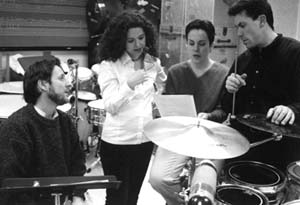How we work

Lake Affect never simply reads poems over standard musical accompaniment. Rather,
we craft a multi-media assemblage of sound that defies traditional notions of music
or poetry. Text takes on a whole new function in our music, and music interacts with
text in a way heretofore unexplored. The musical aspects of language are brought to
the surface and used as compositional elements. Likewise, music starts to behave like
a language, partaking of the structural elements of the poem.
In its work with poets, Lake Affect has developed a number of techniques, which have
proved very fertile. Poetic metaphors, images, atmospheres, poetic formal structures,
semantic meanings --any and all can be used as jumping off points for artistic
inventions.
Departing from rigorous formal musical training, we aim to break free from all imposed parameters. We constantly strive to force the limits of all preconceived notions and standards.
The collaborating poet gives us several poems, and we select a few that suggest sonic possibilities. All the pieces are the result of an experimental group compositional process, keeping those elements (musical phrases, instrumentation, rhythmic patterns, and special sound effects) that work best. Some of the creative techniques are the free improvisation, exchange of ideas with the poets, and analytical discussions on the poem’s form and sonic material. At the end of this process, firm decisions are made, so that each piece achieves its own musical and structural identity.
The musical form of some pieces is extracted from the formal structure of the poem or
the special reading that its author gives of it. For example, City of Webs throws
together an accelerating cluster of sounds and speech fragments that matches the
background taped voice of the poet delivering his piece in its two dimensions: its
wandering reading around the page and its nasal chanting timbral nature.
The sonic material becomes thematic in other pieces like A moment. Its phonemes are
brought alive as living creatures, being both transformed and elaborated into musical
evocations: the "crow" (protagonist of the poem) is now a "lion roar" or a rolling "r"
sung inside a "cowbell."
There are also semantic approaches. Lorca is buried here honors the original gypsy
roots of García Lorca and his unknown burial place with the bells of his non existent
funeral and a Gypsy-Moorish lament of the voice that languishes in an ecstatic
"saeta."
The quartet uses a sophisticated variety of instruments: two full sets of percussion
(tam-tams, cow bells, vibraphone, marimba, chimes, lion roar, loujon, etc), synthesizer
and amplified or processed voice.
Both in live performances and recordings, we encourage collaborating poets to read their works before or after our rendition. We have even in recent pieces worked to model our versions over the simultaneous live reading of the poet or prerecorded processed tape of their voices. This juxtaposition has been successful in highlighting the trajectory from the poem to our creation.
Last modified: September 8th, 2001.© Lake Affect